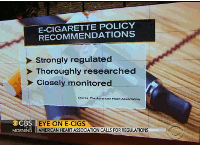
FOR THE WEEK OF SEP. 01, 2014
E-cigarettes prompt new health concerns about young users, targeted with ads and flavors

![]() Identify coverage of a local, state or national government effort aimed at public safety and summarize your reaction.
Identify coverage of a local, state or national government effort aimed at public safety and summarize your reaction.
![]() Can you find news or an ad with a product not intended for minors. Tell why that does or doesn't make sense.
Can you find news or an ad with a product not intended for minors. Tell why that does or doesn't make sense.
![]() Look for another medical or wellness report and tell how it's important.
Look for another medical or wellness report and tell how it's important.
There's a revived debate over electronic cigarettes, which critics fear could appeal to young nonsmokers and lead to the real thing. A leading heart health group urges the federal government to ban the sale of battery-run flavored cigarettes to minors and says they should be regulated just like the traditional kind. "Many advertisements have themes that promote rebelliousness and glamorize e-cigarette use, which conveys the message to youth that e-cigarette use is fun, socially acceptable and desirable," the American Heart Association notes in a new policy statement.
The battery-powered, pen-sized devices release nicotine-laced water vapor instead of smoke. Users can adjust the level of nicotine, the addictive substance in cigarettes. The electronic alternatives, available in America since 2007, are sold online and even by major tobacco firms. Liquids that make their vapor come in tempting flavors like apple pie, banana cream, chocolate, mango, blackberry, watermelon and dozens of others. There now are 466 brands, with global sales reaching $3 billion last year – though little is known about the health effects.
New figures show e-cigarette use is up among adolescents and teens. The number of U.S. middle school and high school students who say they've tried e-cigarettes, but not traditional cigarettes, rose by about 60 percent from 2012 to 2013, the Centers for Disease Control and Prevention said last week. "E-cigarette use was associated with increased intentions to smoke cigarettes," its researchers add.
![]() User says: "I loved smoking cigarettes. [E-cigarettes] changed my life over a year ago . . . The nicotine was something I needed. And now I don't at all. Vaping is now a hobby." – Tabitha Scharenborg of Cape Girardeau, Mo.
User says: "I loved smoking cigarettes. [E-cigarettes] changed my life over a year ago . . . The nicotine was something I needed. And now I don't at all. Vaping is now a hobby." – Tabitha Scharenborg of Cape Girardeau, Mo.
![]() American Heart Association says: "There is robust marketing and advertising of e-cigarettes on television and in magazines, using celebrities as well as flavorings to make these products attractive to children and adolescents. . . . Such marketing practices are likely to recruit a new generation of nicotine addicts." -- Aug. 24 policy statement
American Heart Association says: "There is robust marketing and advertising of e-cigarettes on television and in magazines, using celebrities as well as flavorings to make these products attractive to children and adolescents. . . . Such marketing practices are likely to recruit a new generation of nicotine addicts." -- Aug. 24 policy statement
![]() New data: An estimated 263,000 middle and high school students in 2013 used e-cigarettes but had never smoked regular ones. That's up from about 160,000 in 2012 and about 79,000 in 2011. – Federal report, Aug. 25
New data: An estimated 263,000 middle and high school students in 2013 used e-cigarettes but had never smoked regular ones. That's up from about 160,000 in 2012 and about 79,000 in 2011. – Federal report, Aug. 25
Front Page Talking Points Archive
Common Core State Standard
SL.CCS.1/2/3/4 Grades 6-12: An essay of a current news event is provided for discussion to encourage participation, but also inspire the use of evidence to support logical claims using the main ideas of the article. Students must analyze background information provided about a current event within the news, draw out the main ideas and key details, and review different opinions on the issue. Then, students should present their own claims using facts and analysis for support.
©2024 Boston Herald in Education and Online Publications Inc. and NIEonline.com
![]()
![]()





